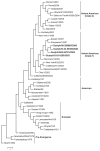Surveillance of equine respiratory viruses in Ontario
- PMID: 21197227
- PMCID: PMC2949340
Surveillance of equine respiratory viruses in Ontario
Abstract
The objective of this project was to develop and implement an active surveillance program for the early and rapid detection of equine influenza viruses in Ontario. For this purpose, from October 2003 to October 2005, nasopharyngeal swabs and acute and convalescent serum samples were collected from 115 client-owned horses in 23 outbreaks of respiratory disease in Ontario. Sera were paired and tested for antibody to equine influenza 1 (AE1-H7N7), equine influenza 2 (AE2-H3N8), equine herpesvirus 1 and 4 (EHV1 and EHV4), and equine rhinitis A and B (ERAV and ERBV). Overall, the cause-specific morbidity rate of equine influenza virus in the respiratory outbreaks was 56.5% as determined by the single radial hemolysis (SRH) test. The AE2-H3N8 was isolated from 15 horses in 5 outbreaks. A 4-fold increase in antibody levels or the presence of a high titer against ERAV or ERBV was observed in 10 out of 13 outbreaks in which AE2-H3N8 was diagnosed as the primary cause of disease. In conclusion, AE2-H3N8 was found to be an important contributor to equine respiratory viral disease. Equine rhinitis A and B (ERAV and ERBV) represented an important component in the equine respiratory disease of performing horses.
L’objectif du présent projet était de développer et mettre en place un programme de surveillance active pour la détection hâtive et rapide des virus de l’influenza équin en Ontario. À cette fin, durant la période allant de octobre 2003 à octobre 2005, des écouvillons naso-pharyngés et des échantillons de sérum prélevés en phase aiguë et de convalescence ont été pris chez 115 chevaux de clients lors de 23 épisodes de maladies respiratoires en Ontario. Les sérums ont été pairés et testés pour la présence d’anticorps contre l’influenza équin de type 1 (AE1-H7N7), l’influenza équin de type 2 (AE2-H3N8), les herpès virus équins de type 1 et 4 (EHV1 et EHV4), et les virus de la rhinite équine A et B (ERAV et ERBV). De manière globale, le taux de morbidité spécifique associé au virus de l’influenza équin dans les poussées de cas de maladies respiratoires était de 56,5 % tel que déterminé par l’épreuve d’hémolyse radiale simple (SRH). Le virus AE2-H3N8 a été isolé de 15 chevaux dans 5 épisodes. Une augmentation d’un facteur de 4 des titres d’anticorps ou la présence d’un titre d’anticorps élevé envers ERAV ou ERBV a été observée dans 10 des 13 épisodes lors desquels le virus AE2-H3N8 a été identifié comme la cause première de la maladie. En conclusion, le virus AE2-H3N8 a été identifié comme étant un contributeur important des maladies respiratoires équines. Les virus de la rhinite équine A et B (ERAV et ERBV) pourrait également représenté une composante importante des maladies respiratoires équines chez les chevaux de performance.
(Traduit par Docteur Serge Messier)
Figures
Similar articles
-
Detection of viruses in nasal swab samples from horses with acute, febrile, respiratory disease using virus isolation, polymerase chain reaction and serology.Aust Vet J. 2007 Jan-Feb;85(1-2):46-50. doi: 10.1111/j.1751-0813.2006.00096.x. Aust Vet J. 2007. PMID: 17300454
-
Genetic Analyses of an H3N8 Influenza Virus Isolate, Causative Strain of the Outbreak of Equine Influenza at the Kanazawa Racecourse in Japan in 2007.J Vet Med Sci. 2008 Sep;70(9):899-906. doi: 10.1292/jvms.70.899. J Vet Med Sci. 2008. PMID: 18840963
-
Identification of equine herpesviruses 1 and 4 by polymerase chain reaction.Aust Vet J. 2001 Aug;79(8):563-9. doi: 10.1111/j.1751-0813.2001.tb10751.x. Aust Vet J. 2001. PMID: 11599819
-
Equine influenza: a comprehensive review from etiology to treatment.Anim Health Res Rev. 2021 Jun;22(1):56-71. doi: 10.1017/S1466252321000050. Epub 2021 Jun 2. Anim Health Res Rev. 2021. PMID: 34075870 Review.
-
A Brief Introduction to Equine Influenza and Equine Influenza Viruses.Methods Mol Biol. 2020;2123:355-360. doi: 10.1007/978-1-0716-0346-8_26. Methods Mol Biol. 2020. PMID: 32170701 Review.
Cited by
-
Respiratory disease and sero-epidemiology of respiratory pathogens in the working horses of Ethiopia.Equine Vet J. 2018 Nov;50(6):793-799. doi: 10.1111/evj.12834. Epub 2018 May 17. Equine Vet J. 2018. PMID: 29574904 Free PMC article.
-
Prevalence and characterization of influenza viruses in diverse species in Los Llanos, Colombia.Emerg Microbes Infect. 2013 Apr;2(4):e20. doi: 10.1038/emi.2013.20. Epub 2013 Apr 24. Emerg Microbes Infect. 2013. PMID: 26038461 Free PMC article.
-
Characterization of Equine Rhinitis B Virus Infection in Clinically Ill Horses in the United States during the Period 2012-2023.Pathogens. 2023 Nov 7;12(11):1324. doi: 10.3390/pathogens12111324. Pathogens. 2023. PMID: 38003789 Free PMC article.
-
Development of one-step TaqMan® real-time reverse transcription-PCR and conventional reverse transcription-PCR assays for the detection of equine rhinitis A and B viruses.BMC Vet Res. 2012 Jul 25;8:120. doi: 10.1186/1746-6148-8-120. BMC Vet Res. 2012. PMID: 22830930 Free PMC article.
-
A longitudinal study describing horse demographics and movements during a competition season in Ontario, Canada.Can Vet J. 2018 Jul;59(7):783-790. Can Vet J. 2018. PMID: 30026628 Free PMC article.
References
-
- Powell DG. A study of infectious respiratory disease among horses in Great Britain, 1971–1976. Proc 4th Intern Conf Equine Infectious Diseases. 1978:451–459.
-
- Van Maanen C, Cullinane A. Equine influenza virus infections: An update. Vet Q. 2002;24:79–94. - PubMed
-
- Sovinova O, Tumova B, Pouska F, Nemec J. Isolation of a virus causing respiratory disease in horses. Acta Virol. 1958;2:51–61. - PubMed
-
- Waddell GH, Teigland MB, Sigel MM. A new influenza virus associated with equine respiratory disease. J Am Vet Med Assoc. 1963;15:587–90. - PubMed
-
- Willoughby RA, Huber L, Vie1 L. Culture and serological results in acute upper respiratory infections in horses. Proc Am Coll Vet Intern Med (ACVIM) Forum. 1989:604–605.
Publication types
MeSH terms
Substances
LinkOut - more resources
Full Text Sources
Other Literature Sources
Miscellaneous

